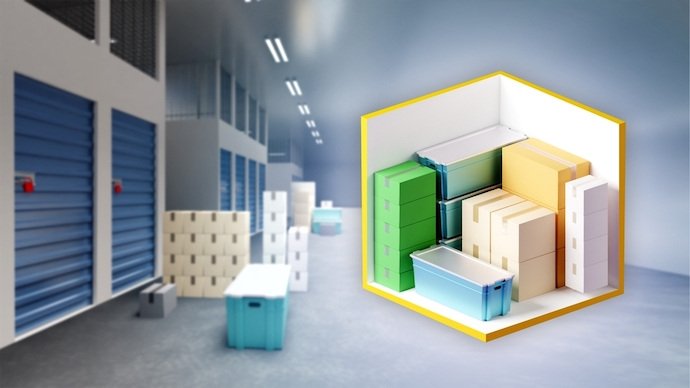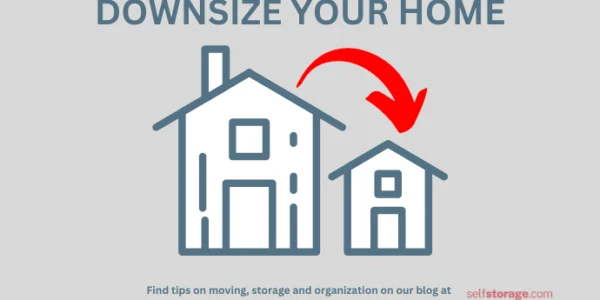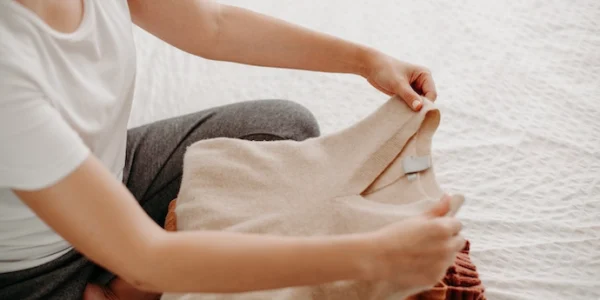Whether you’re in the middle of remodeling the house, downsizing, or are just short on space at home, if you’re someone who needs to access their storage unit on the regular, proper organization of that unit will save you loads of time down the line.
“When I had to organize my storage unit, I learned the importance of proper planning and organization the hard way. Initially, I simply stacked boxes and furniture randomly, thinking I could easily retrieve what I needed later.”
Kelly, self storage unit renter
Kelly’s storage story is all too relatable. Many of us have been there: stuff piling up, boxes scattered everywhere, and absolutely no clue where that one thing you desperately need is hiding. Whether you’re storing personal belongings or professional inventory, this comprehensive guide will show you how to maximize space and convenience, protect your belongings and avoid frustration and wasted time.
Click on a the link to jump that section
- Organize your items
- Make an inventory of your items
- Choose the right boxes
- Label your boxes
- Map out your storage unit
- How to position your items
- Maximize storage space
- Keep your storage unit clutter free
Organize the items you plan to store
When organizing a storage unit, there’s no need to overcomplicate things. Stanimir Danchev, a storage expert with Fantastic Removals, a London-based company specializing in storage containers, advises that you approach the task at hand methodically. Sort the items you plan to store into categories, such as clothing, electronics, documents, and seasonal items. Make sure your items adhere to unit guidelines, and if a storage unit is the appropriate place for each item as there are specific items that cannot be stored in a storage unit.
Make an Inventory of Your Stored Items
Before you load up your unit, Danchev recommends additional organizational support on the front end.
“Use a simple spreadsheet or an inventory management app so you know exactly what you have in storage. You’ll also want to give some special consideration to items you need to access more frequently, because you’ll want to store them front and center for easy retrieval.”
Stanimir Danchev, a storage expert with Fantastic Removals
Choose the Right Boxes
You can either use clear plastic or cardboard boxes for storage, but clear plastic boxes are hardier and will help keep the damp away from clothes, books, and other items susceptible to mildew. Plus, you can easily see into clear boxes. Also stick to boxes that are roughly the same size, and stack large boxes on top of other large boxes and small boxes on top of small boxes — this maximizes space.
Label Your Boxes
Make your life easier by labeling boxes. This way you’ll never be forced to dig around to discover their contents. Use color-coded labels to instantly be able to tell which boxes contain clothes, household goods, books, files, and so on.
Create a Map of Your Storage Unit
Avoid a storage unit maze and make finding your things so much easier by putting your art skills to the test. Sketch a map or layout of your storage unit, either marking the placement of different categories of items, or linking it to an itemized inventory. Then snap a picture of it on your smartphone, file a copy at home and put a hard copy in the storage unit itself for quick and easy reference.
Strategically Position Your Items in Your Unit
One of the most important storage tips is to organize your unit based on how often you’ll them. You don’t want to store items frequently needed buried under loads of boxes, so it’s a good idea to put the items you need often in the front of the unit. It’s also best to leave some space between rows of boxes and furniture, creating walkways and aisles that help you move about freely and find what you need with ease. Use pallets or wooden planks to elevate items off the floor and create additional storage space.
Maximize Your Storage Space
To maximize space in your unit, arrange large, bulky items like furniture towards the back, ideally on either side against the wall. Stack boxes and items securely on sturdy shelving units by placing heavier, less frequently accessed items down low, and lighter items up top.
Bikes, instruments, sporting equipment, tools, and other bulkier items may be able to be hung on special wall-mounted racks and hooks that will help you make the most of your vertical space. Pegboards can also be useful for hanging smaller items, lightweight boxes, and accessories.
Install Shelving in Your Storage Unit
Another way to maximize storage space is to install shelving. Storage facilities may not let you install shelves fixed to the unit wall, but you can bring in garage-type shelving to maximize the vertical space in your storage unit.
A Special Note on Furniture
Heirloom or flat pack, furniture is expensive and bulky, and requires a little extra care in your storage unit.
“If possible, disassemble large furniture items like beds, tables, or shelves to save space. Keep all screws, bolts, and other small parts in labeled bags and attach them to the corresponding furniture piece for easy reassembly.”
Stanimir Danchev, a storage expert with Fantastic Removals
Furniture will require special consideration when creating walkways and may even be able to be stored vertically. Lastly, swaddle your pieces in furniture covers or blankets to protect them from dust and scratches.
Keep Your Storage Unit Clutter-free
Once you’ve arranged your furniture and stacked your boxes in their place, your storage unit should be looking tidy. To keep it clutter-free, consider doing an annual clear-out. Go through your belongings and determine when to keep, donate, sell, and send to the dump.
If storing commercial inventory, check expiration dates and reorder supplies as needed. Routine maintenance makes it easy to declutter and get rid of items you no longer need or use to free up valuable storage real estate.
So, how did Kelly resolve her storage unit woes? First, she made the decision to reorganize her unit and approached it step by step.
“I sorted my belongings into categories and labeled the boxes. I invested in sturdy shelves to optimize the vertical space and placed frequently accessed items within easy reach. Moreover, I chose a climate-controlled storage unit as I had some electronics that I wanted to preserve in good condition.”
“The difference was remarkable! Not only did the organized storage unit look neat and accessible, but I could quickly find the items I needed without rummaging through everything.”
Kelly, self storage unit renter





